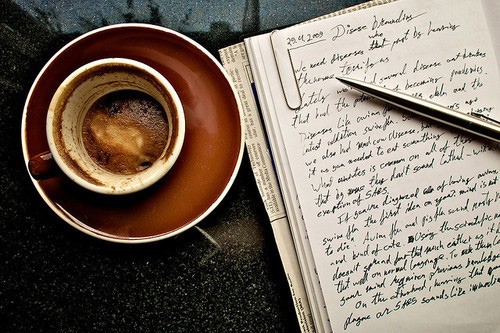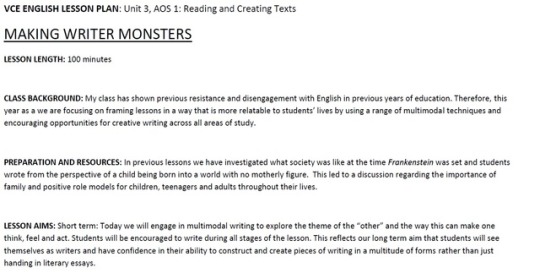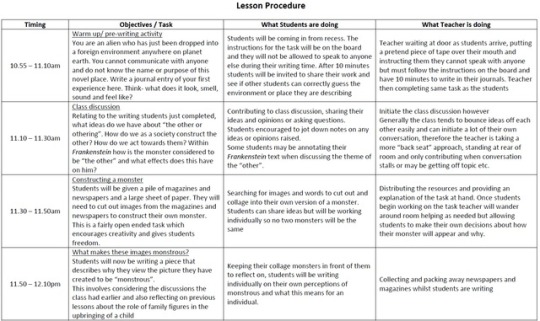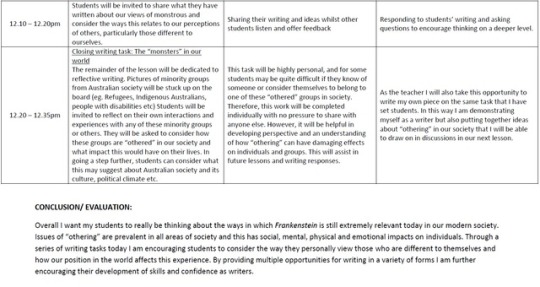Text
Welcome to our workshop of filthy creation…
Hi there, and welcome to my VCE English classroom. Our class is made up of a combination of male and female students from fairly low to mid socio-economic backgrounds. At the beginning of the year many students communicated their previous disengagement and lack of interest in their English classes. They described these lessons as mundane and repetitive and felt as though they simply churned out essay after essay with little relevance to their own lives. Due to this unenthused feel amongst the VCE cohort, the school has given me (as a fairly new English teacher), the exciting opportunity to approach my classes in a new and hopefully more appealing way for students. I believe the key to achieving this is by providing rich opportunities for meaningful writing. We are taking a bold step and diving headfirst into creative writing throughout our English classes each and every day. Currently, the class is exploring Frankenstein (1996) as our text. We are really enjoying the opportunity to ‘think outside the square’ in our approach to both reading and analysing texts but also to our personal favourite; writing our own creative pieces. We hope that you will this insight into enjoy the creative adventure that we are currently pursuing as the making of our own writing monsters is well and truly underway!
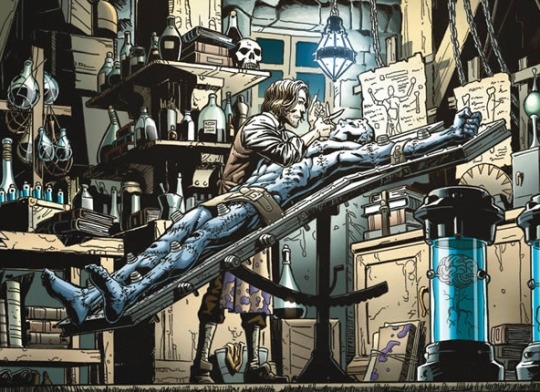
0 notes
Text
Why are we making writing monsters? And why does it matter?
Much of the discourse in recent years relating to Australia’s education system has seen a growing focus on improving the numeracy and literacy skills of our students (Locke 2015). Literacy however, has a very strong focus on reading and comprehension and writing seems to be less involved in curricular documents than ever before. This heavy focus on analysing the writing of others instead of developing students as writers themselves is coming at the cost of individual growth both inside and outside of the classroom (Locke 2015). I believe writing is an extremely powerful tool that has the potential to positively benefit the lives of every individual. It can be used as a technique to build students’ self-confidence, resilience, motivation and foster creativity. It can be both personal and empowering and therefore, by providing authentic writing opportunities for my students, I am supporting my own teaching pedagogy whereby I wish to help my students reach their full potential whether that be within the schoolyard or beyond. Providing rich writing opportunities needs to extend beyond completing a task simply to tick a box and move on.
The Unit 3 VCE English study design states that for Area of Study 1: Reading and Creating texts:
Students present sustained creative responses to selected texts, demonstrating their understanding of the world of the texts and how texts construct meaning. In developing a creative response they explore issues of purpose and audience and make key choices about structure, conventions and language. They develop a credible and effective voice and style and use the chosen features of the selected text, for example characters, narrative or dialogue, to offer an interpretation of the selected text. They produce and share drafts, practising the skills of revision, editing and refining for stylistic and imaginative effect.” (VCAA 2015 , p.18).
Whilst in theory this outcome clearly promotes creative writing, it demonstrates the limited space many teachers feel that they have to teach and promote creative responses in senior years of English (Frawley 2014). Creative writing seems to come down to a simple “tick box” section of the senior English curriculum. I however, feel that creative writing can and should be used by all teachers of writing regularly, regardless of whether their class is at junior or senior levels. As discussed, creative writing offers opportunities for personal growth that I value highly within my classroom. Therefore, I believe creative writing should be interwoven into the fabric of all English classes regardless of the area of study being undertaken. This idea sounds great in itself however putting it into practice and remaining dedicated to it is the hard part. It requires a commitment to developing students to view themselves as writers and acknowledging that this will take time, setbacks and may be met with resistance. However, I strongly believe if the teacher of writing is willing to go that one step further, to think a little left of centre and create writing experiences that are relevant then students will become engaged and willing to undertake a writing journey themselves.

0 notes
Text
Constructing writing experiences for these enthusiastic monsters...
As a teacher of writing I believe often students do not identify as writers themselves due to a lack of confidence but also due to limited opportunity to construct meaningful writing pieces. As Locke proposes, it is common for students to not consider themselves to be a writer just a student “who hands in literary essays” (2015 p.1). Therefore, I believe purposeful planning for writing in each and every class is vital to building students confidence in their own writing whilst also providing authentic opportunities for writing skills to develop. As Gannon (2010) proposes a major issue in English classrooms today is that there is simply not enough writing taking place. In a writing-rich classroom “students will write often… engage with extended prose, write to learn, explore and reflect, but most importantly write for fun and pleasure” (Gannon 2010, p. 226). I strongly agree with Gannon’s ideas and here in my English classroom I encourage personal writing that does not necessarily need to be shared with others but can be written for enjoyment, reflection or insight.
Currently, our VCE English class is working on Area of Study 1: Reading and Creating texts. As selected from the VCE English and EAL Text List (VCAA 2017) we are utilising Mary Shelley’s Frankenstein (1996) as our set text. However, instead of viewing this unit in a reading and responding approach, instead we are framing it as a writing workshop; developing our own monsters and considering ourselves as writing monsters utilising a range of creative responses. My thinking for this approach is informed by both Gannon and Locke who propose that students enjoy a richly creative classroom where they have the opportunity to engage in “multimodal writing… mixing image and sound, with spoken and written words, as they play with time and space in texts” (Gannon 2010, p. 226). As can be seen in my attached lesson plan I provide rich opportunities for creative writing in a number of ways and formats. The lesson begins with a warm-up writing phase that aims to focus students on the task and settle them after coming in from recess or their previous lessons. I have observed many teachers begin their English classes with 10 minutes of silent reading, whilst this can have similar settling effects, instead I have chosen a creative writing task as I feel it really sets the tone for the lesson and, as has been discussed, encourages writing for pleasure which can kick the creative gears of the brain in to motion. Throughout my lesson students are provided with many writing opportunities using a range of formats. Writing time is combined with class discussions as well as a creative collage activity. I have purposely included these elements to provide inspiration and a starting point as many students can find the feeling of staring at a blank page confronting with little idea where to begin (Frank 1979).
The lesson concludes with a writing task where students have the opportunity to write a personal piece that does not necessarily need to be shared with anyone else. This is an authentic opportunity for students to consider themselves as writers without the pressures of assessment or meeting criteria etc. As a teacher I will always offer to read and provide feedback to personal writing however, I also understand some students may not wish to share their work at all.
This lesson is only one sample of our writing classroom in action however, I feel it gives a good insight into the ways creative writing can be planned for and encouraged at a senior level. Creative responses can also be an extremely effective tool to get students thinking about “bigger picture” ideas that a text explores and can help frame this in a way that is more relatable to their own lives.
Below are some sample images of collages created from magazines and newspaper clippings that represent the kind of work students are capable of producing (see lesson plan below for activity description).

0 notes
Quote
The lesson plan below demonstrates a typical lesson in my writing classroom. Click on the picture to enlarge and read
0 notes
Text
Pedagogies and practices in my writing classroom
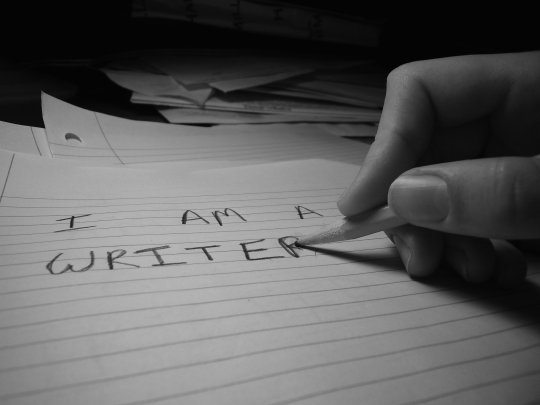
As Locke proposes, as teachers of writing we must first consider ourselves to be writers if we are to truly inspire change and progress within our students (2015 p. 3). Like many others, I hadn’t previously stopped to ask myself this question. Did I consider myself a writer? A writer of emails, reports and lesson plans yes! But a true writer? I wasn’t sure. In developing my confidence as a writer I now engage with meaningful writing in every class with my students. By modelling this and being willing to share my writing even when I know it isn’t perfect, I am encouraging these same behaviours for my students. If I am asking them to sit quietly writing for 15 minutes I believe it is only fair that I too engage with writing during this time.
Furthermore, I believe by developing my own identity as a writer, I will have greater success and confidence when encouraging my students to put themselves out there and take risks in their own work. Many writing teachers are afraid to teach creative writing at senior levels due to the perceived fear of failure (Frawley 2014). This reflects what I believe is an over-reliance on templates and structures to produce literary essays. These methods take away most of the individuality and unique styles from students’ writing and thus leave them with a fear of creative writing when suddenly they have freedom to express themselves in whatever way they choose. To avoid this in my classroom I will be providing creative writing opportunities in all of my classes rather than focusing on it in one single unit. Doing this, I believe will also assist students to strengthen their writing flair within their literary essays and across all areas of their education. Writing is not only confined to the English classroom, therefore developing students into confident and capable writers will have direct benefits for their education as a whole which aligns with my own personal teaching pedagogy.
0 notes
Quote
Thank-you for venturing into our workshop of filthy creation! I hope I have given you a small peak into the exciting writing monsters we are creating and the journey of writing that we are on together
Tiarne
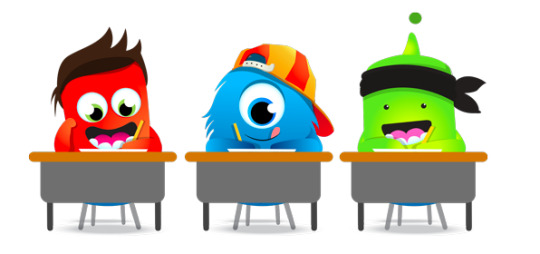
0 notes
Text
Reference List
Frank, M 1979, If you’re trying to teach kids how to write, you’ve gotta have this book!, Incentive Publications, Nashville, Tennessee USA.
Frawley, E 2014, ‘No time for the ‘Airy Fairy’: Teacher Perspectives on Creative Writing in High Stakes’, English in Australia, vol. 49, no. 1, pp. 17 – 26
Gannon, S 2010, ‘Creative Writing’, in S Gannon, M Howie & W Sawyer (eds) Charged with Meaning, Phoenix Education, Putney NSW, Australia.
Locke, T 2015 Developing Writing Teachers, Routledge, New York, USA.
Shelley, M 1996, Frankenstein, Norton Critical Edition, Norton, New York.
Victorian Curriculum and Assessment Authority 2015, Victorian Certificate of Education English and English as an Additional Language Study Design, VCAA, Melbourne, Australia.
Victorian Curriculum and Assessment Authority 2017, VCE English and English as an Additional Language (EAL) Text List 2017, VCAA, Melbourne, Australia.
0 notes
